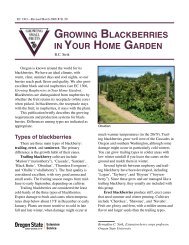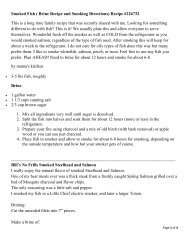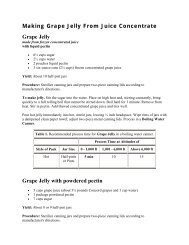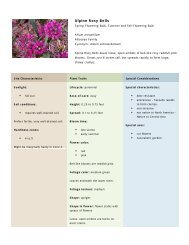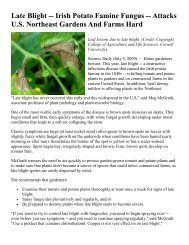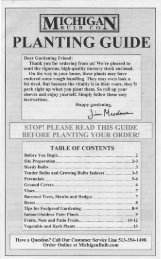Strawberry and Raspberry Pest Management in Wisconsin
Strawberry and Raspberry Pest Management in Wisconsin
Strawberry and Raspberry Pest Management in Wisconsin
Create successful ePaper yourself
Turn your PDF publications into a flip-book with our unique Google optimized e-Paper software.
products are taken up through leaves <strong>and</strong> then transported to roots,<br />
they require thorough wett<strong>in</strong>g of foliage.<br />
Several highly effective fungicides can manage the most important<br />
diseases <strong>in</strong> Wiscons<strong>in</strong>. Many newer products are considered “reducedrisk”<br />
because of their relatively low toxicity to humans <strong>and</strong> wildlife.<br />
However, many are also at great risk of hav<strong>in</strong>g fungal pathogens<br />
develop resistance to them. Most product labels <strong>in</strong>clude<br />
recommendations for resistance management, <strong>in</strong>clud<strong>in</strong>g limits on the<br />
number of sprays per season or number of consecutive sprays of a<br />
“resistance group.” Most labels specify a resistance group number,<br />
based on a fungicide’s mode of action <strong>and</strong> chemical class. For the<br />
purpose of resistance management, fungicides <strong>in</strong> the same resistance<br />
group are considered identical. For example, Abound is <strong>in</strong> resistance<br />
group 11. One component of Prist<strong>in</strong>e is also a group 11 fungicide.<br />
Therefore, Abound <strong>and</strong> Prist<strong>in</strong>e are equivalent <strong>in</strong> a resistance<br />
management program.<br />
PREPLANT SOIL FUMIGATION Soil fumigation reduces the populations of soilborne fungi <strong>and</strong><br />
nematodes <strong>and</strong> should be considered when establish<strong>in</strong>g a plant<strong>in</strong>g if<br />
fruit or vegetable crops have previously been grown on the site. Most<br />
fumigants are restricted-use pesticides <strong>and</strong> may be applied only by<br />
certified applicators.<br />
FUNGICIDE RESISTANCE Many fungicides are specific <strong>in</strong> the way they kill fungi. This specific<br />
nature is good <strong>in</strong> that non-target, beneficial microorganisms are often<br />
spared, but bad <strong>in</strong> that disease-caus<strong>in</strong>g fungi can readily develop<br />
resistance to the fungicide. To prevent the development of fungicideresistant<br />
pathogens, never use Elevate, Rovral, Nova, Cabrio, or Prist<strong>in</strong>e<br />
exclusively <strong>in</strong> a season-long program. Also, try to reduce the total<br />
number of fungicide applications . See product labels for specific<br />
recommendations on resistance management.<br />
DISEASE NOTES<br />
Gray mold<br />
(Botrytis fruit rot)<br />
Gray mold, caused by the fungus Botrytis c<strong>in</strong>erea, can cause losses <strong>in</strong> the<br />
field <strong>and</strong> limits the postharvest storage life of berries to just a few days.<br />
Cultural practices that promote rapid dry<strong>in</strong>g of plants will help prevent<br />
gray mold. The most critical time for fungicide application is dur<strong>in</strong>g<br />
bloom, s<strong>in</strong>ce the fungus can <strong>in</strong>fect flowers <strong>and</strong> then rema<strong>in</strong> “dormant”<br />
until fruit ripen. Make the first application when about 5–10% of the<br />
flowers are open <strong>and</strong> a second application dur<strong>in</strong>g full bloom. If you<br />
have different cultivars that bloom at different times, treat them<br />
separately.<br />
Cane diseases Cane blight, spur blight, <strong>and</strong> anthracnose are caused by fungi that<br />
overw<strong>in</strong>ter on dead canes. Therefore, remov<strong>in</strong>g canes from the site<br />
reduces the <strong>in</strong>oculum available for the follow<strong>in</strong>g year. If this is<br />
impractical, then chopp<strong>in</strong>g canes with a flail mower will accelerate their<br />
decomposition <strong>and</strong> prevent the fungi from overw<strong>in</strong>ter<strong>in</strong>g. Cultural<br />
practices that promote air circulation <strong>and</strong> dry<strong>in</strong>g of foliage, such as<br />
narrow<strong>in</strong>g rows <strong>and</strong> ma<strong>in</strong>ta<strong>in</strong><strong>in</strong>g proper cane density with<strong>in</strong> rows, will<br />
also deter these diseases. Liquid lime sulfur applied when buds show<br />
1/4–1/2 <strong>in</strong>ch green will kill <strong>in</strong>oculum that has overw<strong>in</strong>tered. If applied<br />
later, however, lime sulfur can damage the plants.<br />
Fire blight Fire blight on raspberry is caused by the same bacterial species (Erw<strong>in</strong>ia<br />
amylovora) that causes fire blight on apple <strong>and</strong> pear. However, the<br />
stra<strong>in</strong>s that <strong>in</strong>fect apple <strong>and</strong> pear will not <strong>in</strong>fect raspberry <strong>and</strong> vice<br />
versa. Infected canes become blackened as though scorched by fire <strong>and</strong><br />
33




